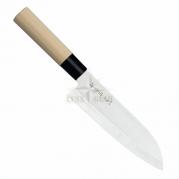Kasumi Tora Chef Japanese kitchen knife

Description
Chef Japanese Knife from TORA series knives from KASUMI, Japan.
These are japanese kitchen knives with Molybdenum Vanadium stainless steel blade with high Carbon.
The cutting edge perfectly sharp and polished is perfected by a double finish process and by a system of Japanese water grinding wheels grained #3000 to obtain a professional very sharp blade.
Magnolia wood handle with Black Epoxy coating.
KASUMI Japan professional japanese knife, a truly exceptional product with quality materials and an excellent design, guarantee of elegance in your kitchen.
These are japanese kitchen knives with Molybdenum Vanadium stainless steel blade with high Carbon.
The cutting edge perfectly sharp and polished is perfected by a double finish process and by a system of Japanese water grinding wheels grained #3000 to obtain a professional very sharp blade.
Magnolia wood handle with Black Epoxy coating.
KASUMI Japan professional japanese knife, a truly exceptional product with quality materials and an excellent design, guarantee of elegance in your kitchen.
- Blade length: 20 cm
- Blade: DSR1K6 Molybdenum Vanadium stainless steel
- Hardness: 56-58 +/-1 HRC
- Cut: V type
- Handle: Magnolia Wood with Black Epoxy Coating
- Made in Japan
TIPS FOR VALUE PRESERVATION OF YOUR JAPANESE COOKING KNIVES
- Never letthe knife get completely blunt. Sharpen it regularly with a high grade CHROMA whetstone. Like every good knife, a Japanese cooking knife never belongs in the dishwasher, because the aggressive salts attack the steel as surface rust. Also do not leave any knives in a wet sink.
- After every use you should clean your knife with lukewarm water and dry it afterwards. Our knives are made of special steel and have the typical "V" JAPAN- GRINDING. This makes our knives sharper than all common kitchen knives. CHROMA knives remain sharp also longer than MANY others.
SHARPENING INSTRUCTIONS (with water stones)
- Initially soak the stone in water for 15 minutes. During sharpening, always keep the stone wet, you can sprinkle it with some water if you think it is drying out. The water works like a lubricant on the stone.
- The knife should be held at a 10-20° angle to the whetstone. Then the knife is drawn off on the stone, in other words drawn back and forth with light pressure. During the grinding operation a sludge forms which assists the grinding of the edge. Knife blades with a single edge are sharpened on the right side to 80% and on left to 20%, whereas knives with edges on both sides are sharpened knives to 70% on the right and to 30% on the left. After sharpenimg the knife should be cleaned well with lukewarm water and SHARPENING & POLISHING INSTRUCTIONS for CHROMA READY-TO-USE-Whetstones ST-IS1, ST-IS2 UND ST-IS3
- Pour a sufficient amount of water on the whetstone to moisten the surface. You can immediately begin with polishing. The right-hander starts polishing the right side of the knife – facing the point of the knife away from the body. Left-handers start with the left side of the blade.
- Please hold the knife securely. Draw the blade back and forth in an angle as shown in the illustration. It is best to start polishing with the point of the knife continuing with the middle and the lower part of the blade. Once you detect an edge at the opposite side to the one you are polishing, proceed with the next part to be polished. Moisten the stone if necessary. The abrasive slurry which forms on the stone is very important to the polishing process and should be removed only after polishing. Repeat this process on the other side of the blade. This side requires less effort. Once the burr is removed the polishing is complete. The knife should be cleaned with lukewarm water and dried with a soft dishcloth. The whetstone should be rinsed with water and be dried afterwards.
Related Products
Total Reviews: 0
Average Rating:
5 Star 0
4 Star 0
3 Star 0
2 Star 0
1 Star 0









